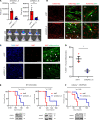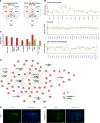Nonredundant, isoform-specific roles of HDAC1 in glioma stem cells
- PMID: 34494550
- PMCID: PMC8492336
- DOI: 10.1172/jci.insight.149232
Nonredundant, isoform-specific roles of HDAC1 in glioma stem cells
Abstract
Glioblastoma (GBM) is characterized by an aberrant yet druggable epigenetic landscape. One major family of epigenetic regulators, the histone deacetylases (HDACs), are considered promising therapeutic targets for GBM due to their repressive influences on transcription. Although HDACs share redundant functions and common substrates, the unique isoform-specific roles of different HDACs in GBM remain unclear. In neural stem cells, HDAC2 is the indispensable deacetylase to ensure normal brain development and survival in the absence of HDAC1. Surprisingly, we find that HDAC1 is the essential class I deacetylase in glioma stem cells, and its loss is not compensated for by HDAC2. Using cell-based and biochemical assays, transcriptomic analyses, and patient-derived xenograft models, we find that knockdown of HDAC1 alone has profound effects on the glioma stem cell phenotype in a p53-dependent manner. We demonstrate marked suppression in tumor growth upon targeting of HDAC1 and identify compensatory pathways that provide insights into combination therapies for GBM. Our study highlights the importance of HDAC1 in GBM and the need to develop isoform-specific drugs.
Keywords: Brain cancer; Cancer; Epigenetics; Oncology; Stem cells.
Conflict of interest statement
Figures








Similar articles
-
Histone deacetylase inhibitors exert anti-tumor effects on human adherent and stem-like glioma cells.Clin Epigenetics. 2019 Jan 17;11(1):11. doi: 10.1186/s13148-018-0598-5. Clin Epigenetics. 2019. PMID: 30654849 Free PMC article.
-
Distinct and redundant functions of histone deacetylases HDAC1 and HDAC2 in proliferation and tumorigenesis.Cell Cycle. 2011 Feb 1;10(3):406-12. doi: 10.4161/cc.10.3.14712. Epub 2011 Feb 1. Cell Cycle. 2011. PMID: 21270520 Free PMC article.
-
DHHC protein family targets different subsets of glioma stem cells in specific niches.J Exp Clin Cancer Res. 2019 Jan 18;38(1):25. doi: 10.1186/s13046-019-1033-2. J Exp Clin Cancer Res. 2019. PMID: 30658672 Free PMC article.
-
HDAC1 and HDAC2 in mouse oocytes and preimplantation embryos: Specificity versus compensation.Cell Death Differ. 2016 Jul;23(7):1119-27. doi: 10.1038/cdd.2016.31. Epub 2016 Apr 15. Cell Death Differ. 2016. PMID: 27082454 Free PMC article. Review.
-
Advances in histone deacetylase inhibitors in targeting glioblastoma stem cells.Cancer Chemother Pharmacol. 2020 Aug;86(2):165-179. doi: 10.1007/s00280-020-04109-w. Epub 2020 Jul 7. Cancer Chemother Pharmacol. 2020. PMID: 32638092 Review.
Cited by
-
Deacetylation of Transcription Factors in Carcinogenesis.Int J Mol Sci. 2021 Oct 30;22(21):11810. doi: 10.3390/ijms222111810. Int J Mol Sci. 2021. PMID: 34769241 Free PMC article. Review.
-
HDAC Class I Inhibitor Domatinostat Induces Apoptosis Preferentially in Glioma Stem Cells Through p53-Dependent and -Independent Activation of BAX Expression.Int J Mol Sci. 2025 Aug 13;26(16):7803. doi: 10.3390/ijms26167803. Int J Mol Sci. 2025. PMID: 40869124 Free PMC article.
-
Paromomycin targets HDAC1-mediated SUMOylation and IGF1R translocation in glioblastoma.Front Pharmacol. 2024 Dec 11;15:1490878. doi: 10.3389/fphar.2024.1490878. eCollection 2024. Front Pharmacol. 2024. PMID: 39723246 Free PMC article.
-
Epigenetic Regulation of OLIG2 in Glioblastoma: Mechanisms and Therapeutic Targets to Combat Treatment Resistance.J Mol Neurosci. 2025 Aug 31;75(3):112. doi: 10.1007/s12031-025-02402-y. J Mol Neurosci. 2025. PMID: 40885881 Review.
-
Quisinostat is a brain-penetrant radiosensitizer in glioblastoma.JCI Insight. 2023 Nov 22;8(22):e167081. doi: 10.1172/jci.insight.167081. JCI Insight. 2023. PMID: 37991020 Free PMC article.
References
Publication types
MeSH terms
Substances
Grants and funding
LinkOut - more resources
Full Text Sources
Molecular Biology Databases
Research Materials
Miscellaneous

